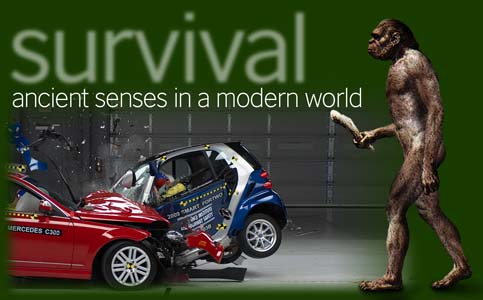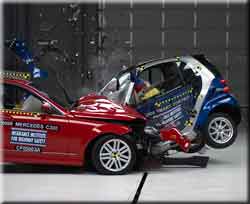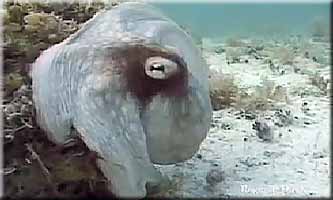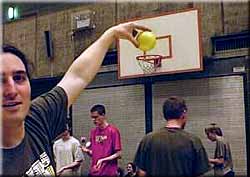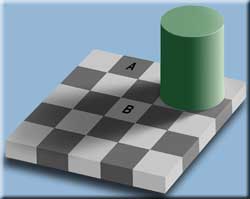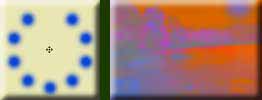|
|
||||||||||||||||||||||||||||||||||||||||||||||||||||||
|
The Survival show ("ancient senses in a modern world") is a brief introduction to the fact that the senses (and for this show in particular, vision and hearing) were honed by evolution to allow our ancestors to survive in a world very different from the one in which we now live. Those senses are well adapted to allow us to make our way in the world, but occasionally the way in which they are wired to react to external stimuli can be less than ideal, and in some cases even harmful! The sections below provide more information on some of the topics covered in the show. |
||||||||||||||||||||||||||||||||||||||||||||||||||||||
|
Senses for survival: an evolutionary tale
For example: why do we have stereoscopic, colour vision? Why do our ears respond well to some frequencies, while being deaf to others? Why do our senses respond at certain speeds? Why do we have sophisticated sensory mechanisms that can pick out certain features of our environment, while being completely unaware of others? Understanding our evolutionary ancestry is the only way in which we can begin to answer questions such as these (well, without invoking magic tricks, of course...) The Senses for Survival show is intended to explore some of the questions above, while introducing our audience to some of the more unusual aspects of our vision and hearing. (As with the Senses show – with which this show shares some of the material – the Survival show concentrates on those two particular senses: out of the five (or six) main human senses, they're the ones that best fit an interactive presentation to a large audience.) |
||||||||||||||||||||||||||||||||||||||||||||||||||||||
|
|
||||||||||||||||||||||||||||||||||||||||||||||||||||||
|
Perception: the first film As a lively introduction to our show (and to get the audience concentrating) we begin by discussing the way in which we have to focus our attention on the information which has been gathered and processed. Our senses produce copious amounts of information for the brain, but it's the way in which we process and integrate this sensory data that lets us make sense of the world around us. We return to this subject at the end of the show. (Note that this link takes you to a page from our Senses presentation.)
|
||||||||||||||||||||||||||||||||||||||||||||||||||||||
|
|
||||||||||||||||||||||||||||||||||||||||||||||||||||||
|
Camouflage
Our senses didn't evolve in isolation. In many biological systems, it's not simply the physics of the inanimate surroundings that has an impact on an organism: pressures are exerted by the direct interaction (and often competition) that it faces with every other living thing in its immediate environment.
Nowhere is this more starkly evident than in the competition between predators and prey. Evolutionary "arms races" are the result of the survival pressures on both sides of the relationship: changes that make it less likely that prey will be captured (slightly less visible, slightly faster, more toxic) , or any small advantage for the predator (slightly better vision or hearing, greater speed or agility, for example) will be passed onto offspring. (This is all entirely unconscious, of course: survival merit is a remorseless improver of systems.) Camouflage is a wonderful demonstration of just how sophisticated the end-products of millions of years of competition can be, especially in the clips used in the show. (We also introduce you to some human-engineered examples of "merging into the background...") The extraordinary disappearing octopus... Look at the two images below, taken from a short film. It's hard to believe, but the octopus resting on the coral in the left-hand image is still there in the picture on the right. Only a few seconds separate the two scenes...
Our film clip of this transformation, taken from the full presentation below, is here (or click on the images above. This scene is part of a presentation that was given by the ocean exploring pioneer David Gallo, at the TED website. TED brings together people from the worlds of technology, entertainment and design (hence the name). From the TED website:
Click here to see Gallo's original TED film from which our clip was taken. |
||||||||||||||||||||||||||||||||||||||||||||||||||||||
|
|
||||||||||||||||||||||||||||||||||||||||||||||||||||||
|
Perception: fading and flashing We are good at spotting changes in our environment, but only under certain conditions (conditions that were likely to occur in the world of our ancestors, and for whom the ability to respond might mean the difference between life and death).
The Visual Cognition Lab at the University of Illinois has information on the fading and flashing clips used in our show at this link under the heading "Gradual Changes to Scenes". (Well, we created the A380 clip, opposite. Click on the image or this link, to download an MP4 video file.) |
||||||||||||||||||||||||||||||||||||||||||||||||||||||
|
|
||||||||||||||||||||||||||||||||||||||||||||||||||||||
|
"The ones out there are far away..."
Our visual system is well-adapted to the determination of object size and distance: assisted by our stereoscopic vision, and using movement cues. Occasionally, however, we can be fooled into thinking that something is the wrong size.... |
||||||||||||||||||||||||||||||||||||||||||||||||||||||
|
|
||||||||||||||||||||||||||||||||||||||||||||||||||||||
|
Fear and the senses
One of the things we discuss in the show is the huge amount of processing power required by the brain to make sense of the sensory information coming from the eyes and ears. The visual system, in particular, has over thirty specialised areas for dealing with different aspects of what at first appears to be simply seeing the world. All of this processing does, however, take time, and an organism needs to respond quickly to external stimuli, if it's to survive. (It does you no good if it takes you two minutes to work out that the changing pattern of light and shade in front of your eyes is in fact a charging lion...) There are lots of short-cuts that have evolved over the aeons to allow a limited brain to quickly draw the correct conclusions, without having to process every single iota of incoming information. In many cases, those short-cuts can be explored by the use of specialised images or sounds, including many optical and auditory illusions (some of which can be found on the Senses show page). Reducing processing time There are other times when it may be appropriate for your brain to speed up its general processing of sensory information, or even to cut off certain senses entirely! Another evolutionary mechanism that has conferred survival merit on organisms that developed it is the response to life-threatening events. Reflexes are one example of this: in some cases we can respond to dangerous events – such as a hot object touching the skin, or an object approaching the eyes quickly – faster than our brains could consciously process and respond to the sensory information.
Other changes occur, as well. Blood flow to your muscles is increased, and flow to the skin is correspondingly decreased, as a prelude to your "fight or flight" response. Again, if we look at this from an evolutionary perspective, this is a good survival adaptation: get ready to run away, or to defend your life! In the modern world... Of course, these mechanisms were ideal for our plains-dwelling ancestors (most likely originating in or near northern Africa, before spreading out across the world), but in the modern world our evolved fight-or-flight responses can be distinctly unhealthy. In a highly stressful situation (before an exam, for example), our bodies will respond in the same way as described above, which over time can cause damaging effects to our heart and arteries (increasing blood pressure, for example), and can even cause changes to the way our brain operates (damaging long-term memory, among other effects). |
||||||||||||||||||||||||||||||||||||||||||||||||||||||
|
Who's in control?
As examples, we use a few popular optical illusions, which you can examine by clicking here, or on the image opposite. |
||||||||||||||||||||||||||||||||||||||||||||||||||||||
|
|
||||||||||||||||||||||||||||||||||||||||||||||||||||||
|
Senses get "tired": neural adaptation
|
||||||||||||||||||||||||||||||||||||||||||||||||||||||
|
|
||||||||||||||||||||||||||||||||||||||||||||||||||||||
|
Hearing Things
The final part of the survival presentation, covering the |
||||||||||||||||||||||||||||||||||||||||||||||||||||||
|
|
||||||||||||||||||||||||||||||||||||||||||||||||||||||
|
||||||||||||||||||||||||||||||||||||||||||||||||||||||








